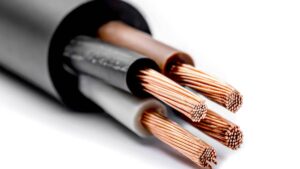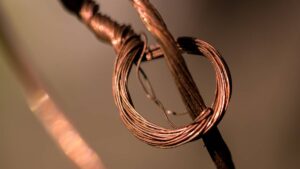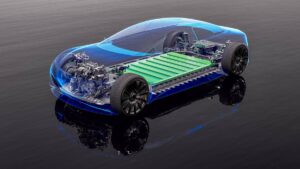Chalice boss warns West’s tortoise-like approach will help China pull ahead in battery metals race

One sec. Via Getty
- Just as it stretches to catch up, the West could fall further behind China in the critical minerals race, miners warn
- Chalice Mining MD Alex Dorsch says long development timeframes and slow approvals in the West will help China’s devil-may-care attitude to building EV supply chain
- Australian and Western miners hopeful their battery metals will boast a ‘green premium’ for US and European carmakers eager to secure non-China materials
From the Inflation Reduction Act to the Australian Critical Minerals Facility, Western governments are talking a big game about competing with and isolating China as they build supply chains for future facing metals like lithium, rare earths and nickel.
But mining bosses warn the West could fall further behind China and Indonesia as they flop and flail like a harmless Magikarp that will never hit level 20 and evolve into a scary, powerful Gyarydos.
Chalice Mining (ASX:CHN) MD Alex Dorsch told a panel at the Resource Connect Asia Future Facing Commodities Forum in Singapore slow approval processes could widen the gap and put the West even further behind China as the race for supremacy in battery metals progresses.
“Social licence, permitting greenfields developments is getting more challenging wherever you go, with the sole exception of China and Indonesia,” he said.
“I think China and Indonesia are putting the West to shame with how quickly they’re scaling up, in particular nickel laterite.
“That industry has effectively popped up over the course of seven years — quite incredible — so I think the Western world… we’ve got this real dilemma.”
Chalice owns the Julimar project 70km from Perth in WA. Currently looking for a strategic partner – which could be a downstream processor, carmaker, battery maker or major mining house – the project has been marketed as the largest nickel sulphide discovery in Australia in two decades and its first major palladium and platinum find.
But the Gonneville deposit also sits on farmland near the Julimar State Forest and Chalice has faced opposition from local environmental groups to drilling applications within the forest boundaries.
“What’s the lesser of two evils? Is it climate change or is it major large scale mining expansions and then obviously you have local voices that clash with global priorities,” Dorsch said.
“I think that is yet to be resolved in the space. The government is acutely aware of the challenge, but doesn’t have the answers yet quite frankly.
“What’s clear is that China just operates in a different paradigm in relation to that. They do not hold back and anything of value in any industry is basically exploited to its full and I think if that remains the case the West’s competitive advantage in this space is quickly eroding.”
IRA changing the game
Like Nike pairing with a rookie Michael Jordan to sell shoes, Dorsch acknowledges the introduction of the US Inflation Reduction Act and other similar policies in the West are changing the game.
In time, he sees Western mines garnering ‘green premiums’ for their metals.
“Obviously it would have been hard to predict three years ago that the Australian Government was willing to put money directly into critical minerals projects, so that shows you the direction of travel for the government as a funding partner,” he said.
“The IRA (has) no doubt changed the game for Western car companies. They have business models which are necessitating huge amounts of expansion, lithium and nickel in particular but also copper, graphite all the other prerequisites for electric vehicles.
“The IRA has totally changed the mentality of the North American carmakers but also the European carmakers.
“That is necessitating a green premium for Western product, which quite frankly there’s not enough to go around.
“The heavy lifting must lie with the explorers to actually find more metal in the Western world and then we need to build projects much, much faster.”
Waiting for Godot, uh, we mean copper
Another aspect, and one Dorsch says is an advantage in WA, is access to low cost power.
WA’s rich natural gas reserves, supplied at low costs owing to an historic domestic supply deal brokered years ago by its State Government, makes it an attractive destination for industrial investment.
But the access to hydropower and fast rollout of renewables like solar and wind in many parts of Asia make them attractive investment destinations for green, low emissions metals as well.
AIC Mines (ASX:A1M) MD Aaron Colleran says the development of the $5 billion Copper String 2.0 by the Queensland Government will be critical to its ability to market green copper from the Eloise mine in Queensland.
Located near the famous copper town of Mt Isa, the community is disconnected from the grid and reliant on diesel to power its mining and processing industries.
“This is basically connecting grid power into the copper producing heartland,” Colleran said.
“What’s important about that is there’s two things.
“Grid power will be a third of the price (at which) we use power. Then think that through, we can’t produce green copper with diesel generators, it doesn’t work.
“Connecting into Copper String 2.0 for us is a two-year payback … and we’ll be able to connect to renewable power and produce green copper within Australia.
“That credential is really breakthrough stuff for us and it’s only the government that can help with that and it’s been fantastic they’ve finally stepped up to the plate, approved and taken control of that (project) which has been trying to get off the ground for at least the last two if not three years.
“It’s there, let’s see if they can actually start building it and come in somewhere near budget.”
Still going through China
Lithium, nickel and copper may be the most visible battery metals but they’re not the only ones out there.
5E Advanced Materials (ASX:5EA) is an ASX 300 company which is looking to become just the third boric acid producer in America.
Currently around 65% of material supply comes out of Turkey, with a sizable portion also delivered from Rio Tinto and another operator in California.
But most downstream processing is still done in China. It has led Aussie companies into North America to become not just miners, but manufacturers of critical mineral derivatives in the good ol’ US of A.
“Certainly one of the concepts we’re playing into at least as a US-based company is moving downstream, so the production of boric acid but also the production of advanced materials,” 5EA chief marketing officer JT Starzecki said.
“Boron does have a lot of military and aerospace applications, boron nitrides, boron carbides, tank armour, kevlar, all of that has an input of boric acid.
“We’re in a unique situation in that the US military tends to buy all of that product that’s essentially mined in California, sent to China for processing then is brought back to the US or military applications.
“Our plan is to not only have a captive supply of boric acid but also produce a certain amount of advanced downstream derivatives to lessen that supply (risk) and bring more of the processing back into the US.”
Chalice Mining (ASX:CHN), 5E Advanced Materials (ASX:5EA) and AIC Mines (ASX:A1M) share prices today:

UNLOCK INSIGHTS
Discover the untold stories of emerging ASX stocks.
Daily news and expert analysis, it's free to subscribe.
By proceeding, you confirm you understand that we handle personal information in accordance with our Privacy Policy.








